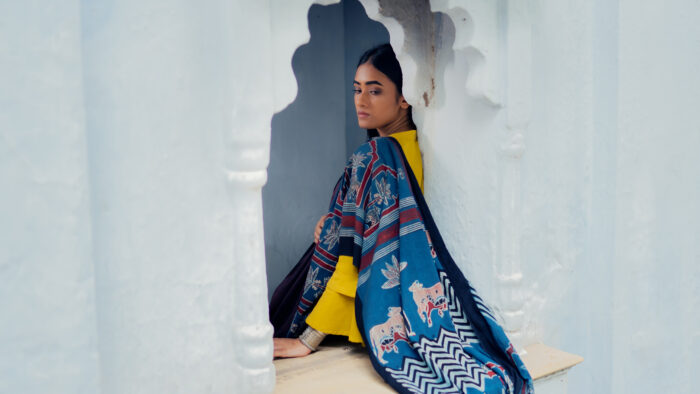Summer of 2009, Bhoomi Dani, a revivalist by her approach, graduated from the National Institute of Fashion Technology where she specialized in Textile Design. She is the Design brain behind the brand and a true Libran who is always caught busy maintaining a perfect balance between traditional crafts and contemporary style to attain the perfect design statement which is at the core of Vraj:bhoomi. After working a few years in the already defined fashion industry, Bhoomi made her way to Kutch, to relive the history of Indian culture by reviving its traditional textiles and launched Vraj:bhoomi in 2013.
She was joined by Priyam Shah, an aviator by academic training and art admirer by passion. His business acumen and astute leadership has helped in making Vraj:bhoomi a label perfectly balanced between craft and commerce. Priyam is also Bhoomi’s life partner, and together they want to encourage people to consider where their clothing comes from and to establish that Indian fashion can be extremely plush whilst maintaining the traditional design philosophy.
In this interview, Bhoomi shares insights on her endeavor to preserve the traditional craftsmanship of Kutch through revival techniques and contemporary fashion design.
What defines Vraj:Bhoomi as a fashion label?
Vraj:bhoomi is a concept clothing label based out of Gujarat, working with desert artisans of Kutch in transforming the traditional hand block printing skills to ethical aesthetic wear. We are into contemporary revival of a textile craft called “Ajrakh”, a form of hand block printing with resist dyeing using natural dye stuffs. But Vraj:bhoomi is much more than just prints and weaves.
Being a textile centric label, we are intensely involved in researching, reviving and sustaining the inherent quality of traditional Indian crafts. We consistently seek to push boundaries in the creation of a new aesthetic using old-world and traditional processes in which the sum of many efforts from the start to the end are all handmade.
Ours is a quest for the Indian contemporary, rooted in its traditions yet global in its charm. ‘Contemporary Revival’ as a design expression is close and lies at the spirit of every creation. The label brings together Indian elements to a sensibility very global in appeal. The label focuses on comfort, ease and thus soft and breathable cotton in relaxed silhouettes characterize Vraj:bhoomi. The exquisiteness of the label rests in the textile process, where materials pass through the hands of one artisan to the other, carrying forward the Indian tradition of the hand made and creating pieces that has a unique story to share.
What inspired you to work with the textile crafts of Kutch, especially Ajrakh?
Kutch is a flourishing vibrant region with its true colours of rich heritage and cultural traditions. There is so much that this place has to offer in terms of inspiration: the music, culture, costumes, traditions, skilled craftsmen. The traditional craftsmen of Kutch, create magic with their hands, with an evolved sense of grace, atypical richness, a brilliance in every creativity.
In the parched land of Kutch-Gujarat, the intricate motifs are hand block printed on fabric; coloured with the dyes extracted from nature and dried out in the open sky as if an offering made to the divine sun. This craft is called Ajrakh. It is a male-dominated craft. It is a 10th generation artisan’s family who has been involved in the art of Ajrakh printing since the 15th century. As the family legend goes, “The king of Kutch invited their forefathers and that’s how they migrated from Sindh and started calling this tiny village their home.”
However, we don’t see Ajrakh, as just another fabric or a craft form!
The bright colours of nature coming to life on the blank canvas of fabric. The fabric undergoes a painstaking process. To witness the creation of Ajrakh is watching a miracle of nature. Life flows from the water, the constant energy from the sun, the sacred, vibrant colours from the plants and rocks, the hands of the artisan, his only tool. The intricately carved wooden blocks from the heart of tree trunks which delicately gives shape to the design on the fabric. The beautiful textiles energized and embellished with hand techniques, the desert artisans, and the diverse culture of Kutch have been a lifelong inspiration at Vraj:bhoomi.
Currently, we are focused on a contemporary revival of Ajrakh, however, we would love to explore and work using other textile crafts as well. The exclusivity of skilled craftsmanship mirrors the vibrant culture of Kutch. At Vraj:bhoomi we are committed to reliving each craft of this cultural land. Extending the philosophy, we would love to explore the intricate hand embroideries and beautiful hand weaves as well.
What are some of the age-old techniques that you have been continuing with and how have you fused them with innovations – both in technical and in design terms.
Historically, Ajrakh was printed on both sides but we do not follow this part of the textile process due to its own limitations in terms of design and pricing. The complicated process of Ajrakh making involves about 14 steps which differ from craftsman to craftsman. The proportions of ingredients used and time taken in all the stages might differ from climatic changes, fabric structure, and availability of raw materials.
Unlike the commercial production process, the idea of a product at Vraj:bhoomi doesn’t start at design level — it begins as a shared effort between the designer and the craftsmen. We work closely with desert artisans of Kutch by providing various inputs including design, quality control, access to raw materials and production coordination.
Every collection we make is focused on reinterpreting the age-old technique of hand block printing called Ajrakh. Instead of relying on forecasts, we have stayed true to its traditional colour palette. The shades and tones of these natural dyes are extensively dependent on their surroundings and thus, the results are highly unpredictable. We follow the traditional process but we blend it with our signature block designs which are contemporary and universal in nature. We have our own unique repertoire of motifs and print artworks. Despite all the restraints of this craft, every collection of ours brings out something ‘nouveau’. Various contemporary motifs are used along with traditional blocks which gives this craft a perfect blend of both. Taking inspiration from across the world, this local craft is given a global twist. We come up with 3 themes a year taking inspiration from Turkish tiles to the pottery and suzanis of Uzbekistan to the traditional Pichwais of Nathdwara!
Vraj:bhoomi's designs unify contemporary sensibilities with traditions of excellence, keeping the spirit of revival always alive. We try and create the perfect synergy of innovative patterns and immaculate tailoring, coming up with designs that suit the classics and contemporary in equal. This process involves exploring the traditional Indian textiles and translating those to the most urban and chic outfits, that connects with people, wherever in the world it is placed.

What is the inspiration behind designing a collection that draws heavily from the colours associated with Krishna?
Vraj is the land of everlasting love,
Enchanting life & lifestyles; Nature's splendor,
Sunshine and moonlit nights;
Charming myths and Eternal truth!
Vraj:bhoomi literally means ‘land of Krishna”. From rediscovering glorious history to the discovery of magnificent traditional textiles and experiencing the divine beauty of it, Vraj:bhoomi is richly interwoven with the enigmatic beauty of outer world and the serene beauty of inner-self.
With a fast pacing and evolving fashion industry, what are some of the trends that are influencing consumer choices now a dats?
According to me, “slow fashion”, “sustainability” and “zerowaste” are majorly influencing the consumer choices. Now more than ever, there is an awareness in the fashion & textile industry about its impact on planet and people. While oil still remains the most polluting industry in the world, the fashion industry comes in at a close second. The reason for this comes down to two crippling words: fast fashion. Sure, the low price points associated with fast fashion can be tempting for any consumer, but the overall price of fast fashion is inflicting havoc on our world, in more ways than one.
Modern-day “slow fashion” encourages us to buy less garments at higher quality, made from more sustainable processes and also puts emphasis on the art of clothes making with zero waste and celebrates the skills of the craftspeople who make them.

What is unique about Indian textile crafts? How can our fashion heritage have a stronger imprint on the global fashion industry?
The second most intriguing aspect of India apart from its rich culture and heritage is the diversity and vastness offered by the Indian textiles. Right from the traditional, artisan-based textiles since the ancient times to the contemporary and globally-acclaimed, chic modern designs, Indian textiles have remained true to its core and essence. Today, the flourishing textile sector of the country continues to lure the world.
Our key strength is highly skilled craftsmanship & entrepreneurial skills backed by the oldest and most diverse culture which is a composite mixture of varying styles and influences. However, when the buzz is generated about resuscitating the dying arts and crafts of India, several design labels have come forward to contribute to this notion. But where they fail to make an actual impact is at the longevity of their contribution. It is observed in the fashion industry, that labels work with a particular craft and handlooms for a season. Once the season changes the craft and artisans associated with it are left on their own.
For Indian fashion and textile crafts to flourish, it is important to perseveringly work with local craftsmen and artisans for a long duration of time. While at the same time, constant innovation and an entrepreneurial approach to bring in new techniques and designs are equally important. Our effort is on the same lines – to maintain a perfect balance between traditional design philosophy and contemporary style to attain the impeccable design statement.





